Neglecting the timing belt replacement regulations is highly discouraged even on such simple engines as the 1.5-liter 8-valve Daewoo Nexia SOHC G15MF engine.
A broken belt or misaligned marks can easily lead to bent valves and even more serious consequences.
Replacing timing belt Daewoo Nexia 8 valves
The Daewoo Nexia 8 valve timing belt is replaced every 40 thousand kilometers. In addition to the timing belt, it is necessary to replace the timing rollers. Moreover, in Daewoo Nexia after 2008, the water pump (pump) is a direct participant in the timing belt drive. Moreover, the timing belt is tensioned using a pump. If the condition of the pump is in doubt, then it is better to change the water pump (pump) along with the belt.
You should not ignore replacing the belt, because if it breaks, the valves will definitely bend, and this is a rather expensive and serious repair. Below are detailed instructions for replacing timing belts in Daewoo Nexia with photographs.
Signs that the mechanism needs to be replaced
How to determine that a 16-valve Nexia needs a timing belt replacement? This can be indicated not only by mileage, but also by the following signs:
- Characteristic noise and vibration at idle. It feels like the engine is running rough.
- It became difficult to start the engine. It takes longer than usual to start.
- Vibration is felt in the body when driving, especially downhill at high speeds.
- The car began to consume more fuel.
This is interesting: Replacing the gasket under the valve cover on a VAZ 2101-2107
All this suggests that it’s time to replace the belt. If you changed it recently, it may have simply jumped a few teeth and therefore the valve timing has shifted. It is also worth monitoring the visual condition of the belt. The presence of cracks, tears and traces of threads on it is unacceptable.
Such a belt can break at any moment. And if on eight-valve engines you can only get by with fear, then in the case of a 16-valve head you will have to fork out for serious repairs.
Replacement timing
The operating instructions for this car recommend replacing worn out timing drive parts with a mileage of no more than 60 thousand km. However, in some cases this mileage may be slightly different. Its mileage depends on the operating conditions of the car, driving style, and the quality of spare parts used. Experts recommend checking the condition of the timing mechanism drive parts every time a technical condition is carried out. The presence of technical fluids in the working area of the timing drive is especially harmful. The most optimal mileage before replacement is 50 thousand km.
What are the consequences of untimely replacement?
If the timing of changing the timing belt in the Daewoo Nexia 16 valves is violated, this can lead to serious consequences for the vehicle. If the wear is critical, the strap will break. As a result, the camshaft will stop, but the crankshaft will continue to work. As it moves, the piston will begin to knock on the valves, which can cause them to bend. The car owner will have to carry out major engine repairs or change the engine. Moreover, the consequences will be more unpleasant for an 8-valve unit. The valves themselves will have to be replaced.
To prevent such problems, it is necessary to constantly monitor the condition of the strap. Product breakage is usually due to natural wear and tear. During long-term use, the belt loses its elasticity, its structure delaminates, and cracks appear on it. The strap may break if the pump or tension roller jams. Sometimes it breaks due to the camshaft not working properly.
Replacing the timing belt Daewoo Nexia 8 valves
To check the condition of the timing belt, remove the air resonance chamber 2 of the intake tract by loosening the clamp 1 and unscrewing the self-tapping screw 3 securing the chamber to the intake pipe.
Using a 10mm socket, unscrew the four bolts securing the upper front timing drive cover and remove the upper front cover from the rear. See the photo below.
We engage fifth gear in the box and hang out the right front wheel. Rotating the wheel clockwise, rotate the crankshaft and check the condition of the timing belt.
To replace the timing belt, remove the air filter. Remove the drive belt for the generator and power steering pump. Remove the power steering pump pulley and loosen the bolts securing the pump to the cylinder block.
For clarity, we show further operations for replacing the timing belt on a dismantled engine. Using a 10mm socket, unscrew the four bolts securing the upper front timing drive cover and remove the cover.
We dismantle the power steering pump.
Using a high “17” head, turn the crankshaft clockwise by the bolt securing the auxiliary drive pulley. We combine the marks on the camshaft gear pulley with the slot on the rear timing cover of the Daewoo Nexia.
In this case, the mark on the accessory drive pulley (located between the 5th and 6th teeth, counted clockwise from the area without teeth) should be opposite the pointer on the lower front timing drive cover.
Using a high “17” head, unscrew the bolt securing the auxiliary drive pulley. To keep the crankshaft from turning, an assistant must engage fifth gear and press the brake pedal. If you cannot unscrew the pulley mounting bolt due to the crankshaft turning, then lock the flywheel.
We take out the bolt and washer and remove the auxiliary drive pulley. Once again, check that the installation mark on the camshaft timing belt matches the slot on the rear timing cover. When the timing of the valve timing mechanism is correctly set, the mark on the crankshaft timing belt should be located opposite the slot on the rear timing cover of the Daewoo Nexia.
Using a 10mm socket, unscrew the three bolts securing the lower front timing drive cover and remove the cover.
We loosen the tension of the timing belt by turning the spring-loaded movable roller bar with a screwdriver clockwise until the hole in it is aligned with the hole in the roller bracket and insert pins with a diameter of 4.0-4.5 mm into both holes (for example, drill shank or screw).
Remove the belt from the timing pulleys of the camshaft and crankshaft and the coolant pump.
Using a 12mm socket, unscrew the bolt securing the tension roller and remove the roller.
Install the new roller in reverse order.
Video of replacing the timing belt of an eight-valve Nexia
Some details are not shown, but the general procedure is covered quite well. I recommend viewing. Good luck on the roads. Not a nail or a rod!
The Daewoo Nexia 8-valve is an improved Opel Cadet. The machine is very popular in many regions of the Russian Federation and other CIS countries. In the period from 1996 to 2002, it was equipped with the G15MF power unit. The timing mechanism drive is driven by a timing belt, which requires careful, timely maintenance.
Most owners replace the timing belt on this car by service station specialists, but some of them perform this operation on their own. Nexia, which has 8 valves in the block head, is a reliable machine, unpretentious in maintenance.
Why are timing marks needed?
The timing marks are marks along which the timing belt is adjusted, as well as the drive belt is replaced. This element is quite important because it directly affects the operation of the power unit.
What happens if, when replacing a belt, you set the marks incorrectly or don’t set them at all? In this case, you can knock down the gas distribution mechanism, which will lead to many problems. Namely:
- Since the gas distribution has been disrupted, the injection and release of exhaust gases will be carried out incorrectly. Subsequently, the engine may start to stall, stall, fail to start, or consumption may increase. In turn, this can lead to consequences, such as increased wear, burnout of the valve mechanism and piston group, and others.
- Everyone remembers what happens when the timing belt breaks - valve bending. This happens because the gas distribution process is disrupted and the pistons hit the valves, which are subsequently deformed. The exact same principle works in this case. A broken timing mechanism will cause the piston group to fight against the valves, which will simply deform them.
- Shifting the timing mark when changing a belt or adjusting will result in fuel being injected too early or too late. The consequence of this may be flooding of the spark plugs or suction of exhaust gases into the combustion chamber.
Replacement timing
Manufacturers recommend replacing worn parts of the timing mechanism drive with a mileage of no more than 50 thousand kilometers. Most owners follow this recommendation, but there are exceptions.
The service life of the belt depends not only on the manufacturer of the spare part, but also on the operating conditions of the vehicle and the technical condition of the engine. The condition of the belt is adversely affected by technical fluids that can get into its operating area. If even the slightest leaks of engine oil are noticed, they are immediately eliminated and the belt is replaced with a new product.
How to set tags
Setting the timing marks is quite simple. Let's consider the sequence of actions:
We stop the car at the inspection hole. We go down into the pit and dismantle the right side of the engine crankcase protection.
First you need to remove the timing belt protective cover. To do this, unscrew the mounting bolts. Of course, the easiest way is to do this with the engine removed, but if you only need to replace the belt and roller, then it is not advisable to dismantle the entire power unit.
Remove the accessory belt.
Remove the accessory belt.
We remove the power steering pump pulley (it is held on by 3 bolts) if the car is equipped with a power steering. Dismantle the upper part of the timing belt protective casing.
Unscrew the crankshaft pulley. You should first ask an assistant to depress the brake pedal.
Rotate the crankshaft pulley until the marks on the pulley and the housing coincide. Additionally, we control the position of the marks on the camshaft pulley. On a Daewoo Nexia with a 16-valve engine, the marks on the camshaft pulleys should face each other.
The mark on the accessory drive pulley must also match the mark on the cylinder block. The camshaft pulley is secured against rotation, and subsequent operations are performed.
We loosen the timing belt tension using the eccentric on the water pump. The eccentric is turned with a special key to 41.
- This is how the timing marks are set easily and simply.
About the engine
Initially, the car was equipped with a G15MF engine running on gasoline. The power system is distributed fuel injection. The engine displacement is 1500 cm3, the camshaft is located in the cylinder head, ensuring operation of 8 valves of the gas distribution mechanism. The timing mechanism is driven by a toothed belt. The engine is capable of developing a power of 75 horses. The disadvantages include poor performance of the distributor in the ignition system.
Later it was replaced by the modification A15SMS, which, with the same displacement, already develops 80 horsepower. The power system has a distributed multipoint injection; the unreliable ignition distributor is no longer used. There are 8 valves installed in the head, the camshaft is driven by a toothed belt. This type of drive requires careful maintenance and care. Experts recommend checking the condition of the timing drive mechanism parts during each regular maintenance.
Are the valves bending?
This problem worries all owners of cars whose timing mechanism is driven by a toothed belt. Its failure can lead to significant damage to engine parts, which will require significant financial costs. Designers are trying to find ways to solve this problem. Most often, engines with four valves per cylinder are susceptible to this problem. For engines G15MF, A15MS, there is no danger of bending valves, damage to pistons or connecting rods.
Read also: Installing rheingold on windows 10
Tools and accessories
There is one peculiarity: the belt is tensioned by a pump and for this we need a special key for 41.
Actually, the key itself and the pump.
The price of the issue is 500 rubles, but if the replacement is a single one, then you can make it yourself by cutting it out of a sheet of metal 1 - 2 mm thick and bending the handle at an angle of 45 degrees. It won’t be very convenient, but you can tighten the belt with such a key, check it yourself.
I apologize for the quality of the photo; my partner’s hands were shaking with excitement.
Process technology
Before you begin replacing old items, you must purchase a new required set of consumables. To replace the belt on a Daewoo Nexia 16 valves without significant difficulties, it is best to arm yourself with a special wrench.
Required tool:
- Socket wrenches;
- Spanners;
- Screwdriver Set;
- Special key for 41;
- Hexagon;
- New materials.
The engine under the hood of the Nexia occupies almost all the space. This promises some difficulties. When dismantling, difficulties arise with the bolts under the hexagon, due to which the pump is attached to the cylinder block. Here it is best to use VD40, but if the device is original and has never been removed, then you cannot do without a hammer and chisel. During subsequent assembly, it is best to use new bolts.
Using a 41 key, turn the pump until the timing belt loosens, after which the element itself is removed. The tension roller is removed by removing the force from three bolts. The water pump bolts are unscrewed, after which the mechanism itself is dismantled. It is best to place any container under the engine, since when dismantling the pump, some will spill onto the ground. There shouldn’t be any special problems with the tags, since it’s not difficult to set them by coincidence.
Photo instructions
During operation, the following sequence should be observed:
- The belt is placed first on the crankshaft pulley and then on the exhaust camshaft bypass pulley.
- When tensioning the element, a special key is installed on the pump and turned clockwise until it matches the mark.
- After which all bolts of the device are tightened.
The tension of the mechanism is checked as follows: the tongue of the roller must coincide with the tongue placed on the platform. If this condition is not met, then by loosening the pump fastening, it is turned and tightened. All that remains is to install the crankshaft pulley, turn it two turns and check that the marks match. Assembly is carried out in reverse order. After completing the work, all necessary fluids are poured in and the engine is started.
Installing a new timing belt will allow the driver to gain peace of mind and confidence on the road. As the manufacturer assures in the operating instructions, replacement must be done every 64,000 km or after 4 years of vehicle operation in order to avoid belt rupture and engine jamming.
How to change the timing belt on a Daewoo Nexia
on one's own
For the long-term operation of any car, it is necessary to regularly carry out technical inspections and necessary replacements. In order not to save money on a car service, there is probably an option to perform the procedure yourself. The text of the article describes the replacement
timing belt on Daewoo Nexia 16 valves yourself: photos and videos that are attached to the article complement the detailed instructions.
Step-by-step instruction
We remove the air intake pipes, the air filter housing and everything connected to them. This is the picture we get.
Unscrew the bolts securing the protective timing cover and remove it. We also loosen the bolts securing the power steering pulley. So that he doesn’t swear later trying to stop him.
Loosen the generator mounting bolt, move it towards the engine and remove the generator belt.
Installing a new timing belt
We put the protective cover in place, screw it and the tension roller. We install the camshaft pulley and align the marks, if they do not match, we also check the crankshaft marks. Then we install a new timing belt so that the descending branch of the belt is tensioned. The principle is this: first we put it on the crankshaft, pump and tension roller. Then we turn the camshaft pulley a few degrees clockwise, put a belt on it and return it back. It turns out that the right branch of the belt is tense, and the left is free.
Be sure to place the belt in the direction of rotation,
There is a special mark on the belt, unfortunately we didn’t take a photo here, but you can see it in the article about Logan.
Using a special wrench, turn the pump until the arrow on the tension roller is against the groove and tighten it.
We check all the marks again. If everything is normal, install the lower casing and crankshaft pulley, tighten it in the same way as you unscrewed it. We turn the crankshaft twice and check the marks.
We screw back everything that was unscrewed and put everything that was removed in the reverse order of removal. Tension the generator belt. Fill with antifreeze. We start the car and accept congratulations from family and friends.
Overall the car is quite good. The front suspension couldn't be simpler, two silent blocks and a ball, which is very difficult to kill. Engines last 300,000 without problems. He does not have a high appetite. The only thing is that there are several congenital electrical defects, and the body rots if not treated. But otherwise, for the money it’s worth, it’s a perfectly acceptable option. These were discussions on a free topic.
We change the belt ourselves on 8 and 16 valve cars
Van046 Blog Refinement of the cylinder head of the VAZ classic
The belt must be replaced according to the regulations or as it wears out. The recommended frequency is every 30-40 thousand kilometers. But it’s better to focus not on the mileage, but on the condition. Necessary.
component tools
In order to replace the strap, you need to prepare a kit which should include the following tools:
- end set;
- spanner wrenches;
- screwdrivers with different special wrenches;
- diameter at “41”;
- hexagon;
- new consumables.
consumables It is better to buy materials from trusted manufacturers, as this guarantees the quality of the product and long-term operation accordingly.
Stages of work
Having prepared the tools and materials, you can begin to work. You can watch the video to understand better.
- First, the housing of the air filter and everything attached to it is removed.
- To access the generator pulley, you need to remove the front right wheel and mudguard.
- Loosen the nut of the air conditioner tensioner roller clamp and remove the roller along with the belt.
- After unscrewing the bolts on the protective timing case, remove it.
- Immediately loosen the mounting bolts on the power steering pulley.
- Having unscrewed the generator bolt a little, you need to move it to the motor and remove the strap.
- Now unscrew the crankshaft pulley bolt.
- Next you need to remove the power steering pulley.
- Before removing the timing belt on the Nexia Daewoo, you need to set the marks. To do this, you need to rotate the entire gas distribution mechanism until the marks on the casing and the camshaft pulley match. The mark on the crankshaft should also coincide with the casing on the mark on the bottom. The camshaft pulley marks should be opposite each other.
- The next step is to loosen the bolt on the tension roller, and then remove it and the strap. If you have a water pump, check its condition and replace it if worn.
- Having installed the new tension roller with your own hands, we tighten the new strap. installation You should start with the crankshaft, pump and tension roller. Next, turning the camshaft in a clockwise direction, put the second branch on it with help.
- We put marks on the pump cranking belt until they match the roller.
Then we tighten the bolts on the water After. - When installing the components, the marks should be checked again; they must match. Next, we return the protective casing and crankshaft pulley to its place.
- screw it on, then do everything in reverse order.
When the replacement is completed, you should start the engine and check its operation. If there are no interruptions, then that's all. The procedure for replacing the timing belt with your own hands on a Daewoo Nexia with 8 cl and 16 cl ends.










